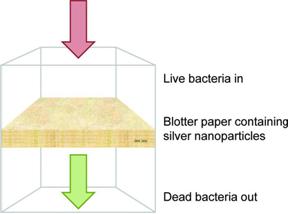Biocidal paper for emergency water purification
This work was carried out as part
of the NSERC
Sentinel Bioactive Paper Network. The aim was to make a cheap, lightweight
paper-based filter for emergency water purification, using biocidal action
rather than simple filtration. In flood disaster areas, there is an
overabundance of contaminated water but a shortage of clean drinking water. Our
aim was to develop a light, cheap paper-based filter that could remove a
significant amount of the most dangerous contaminants. As biocide, we focused
on silver, in both ionic and nanoparticle forms. The aim was to generate a high
concentration of biocide within the paper sheet structure, while minimizing the
amount of metal ions released in the eluent. This was not envisaged as a
routine water purification system, but as way to provide rapid small-scale
assistance in emergency situations. We think it may be easier to store and
transport paper filters than to deliver pure water to disaster areas.

Basic
idea (from Dankovich and Gray, Environmental Sci. Technol., 45(5), 1992-1998
(2011).)
The major challenge was to make
sufficiently pure water in the time that a water sample percolates through the
paper sheet. Initial results on a model suspension of e.
coli showed promise, with a log 5 reduction in live bacteria passing through
the AgNP sheet. (Environmental Sci. Technol., 45(5),
1992-1998 (2011) doi:10.1021/es103302t.)
Dr. Theresa Dankovich has
continued this work, field-testing the concept in several tropical locations,
and setting up a company, Folia Water, to develop the concept of the “Drinkable
Book”.